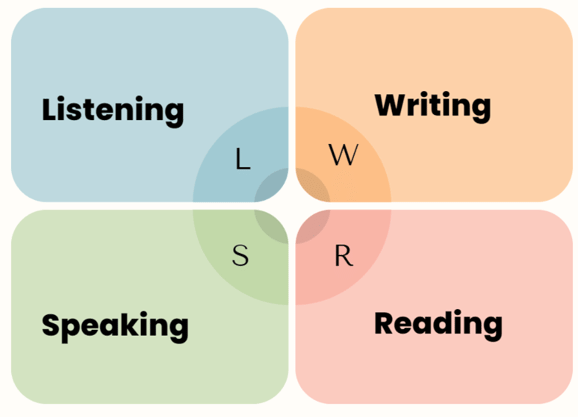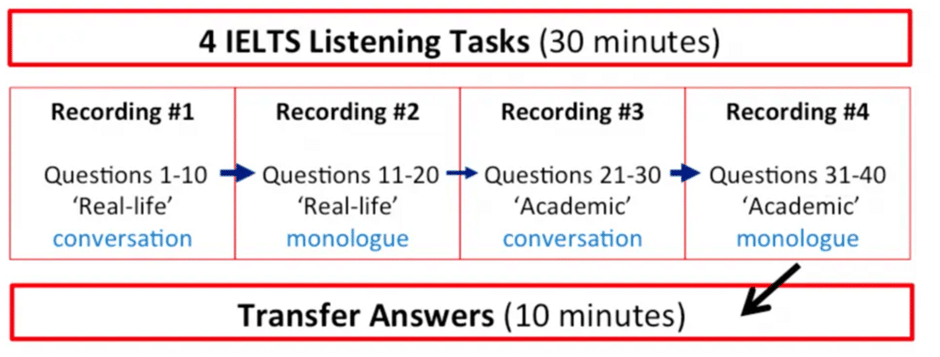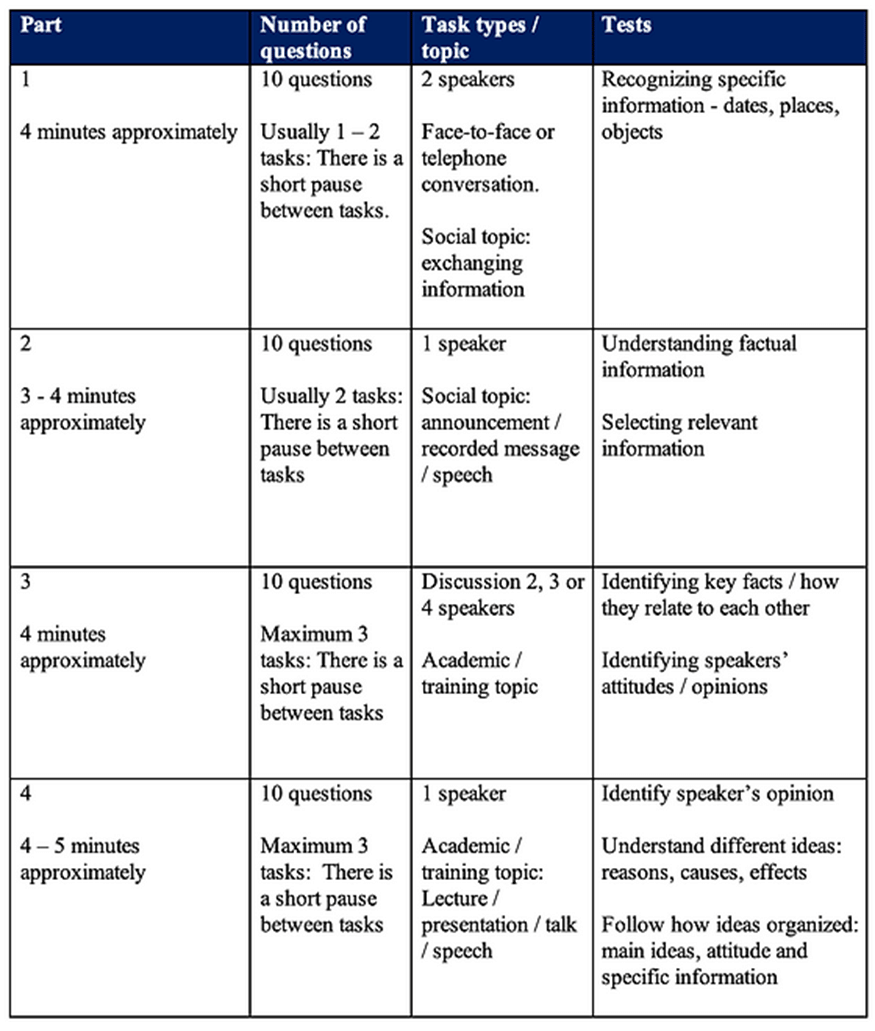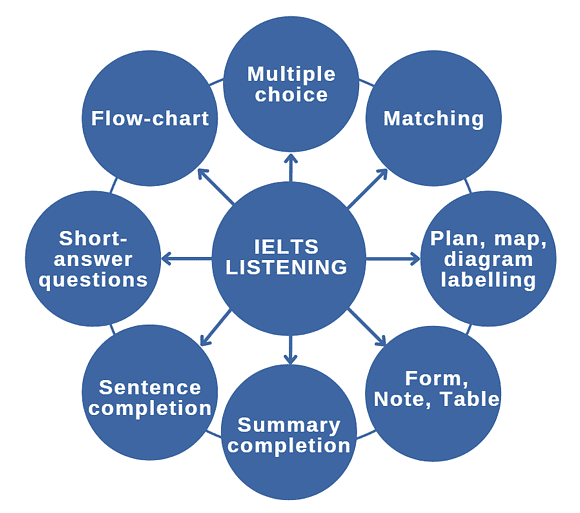Listening Module for IELTS: Exam Pattern & Scoring | Listening for IELTS PDF Download
Jumping into details of what exactly is in the IELTS test, it is important to know that the exam comprises four sub-sections that test your language ability on individual grounds. You must not forget that collective knowledge of all these modules is essential to call yourself an expert user of the English language.
What are the sub-sections?

The sub-sections of the IELTS exam are rendered as the modules of IELTS. There are simply 4 modules, namely:
- Listening
- Reading
- Writing
- Speaking
You can find all the modules for practice on the EduRev app by clicking here.
Let us Discuss the Listening Module in Detail
Test time: 30 minutes
Transfer time: 10 minutes
In the IELTS Listening test, you will need to answer 40 questions in response to four recordings. The Listening test is the same for both the IELTS Academic test and the IELTS General Training test.
What will the Recordings Comprise?
Precisely, you will listen to four recordings which are a mix of monologues and conversations from a range of native speakers. It is very important to know that the recordings will not be played twice but you will only hear each recording once. There are 10 questions for each part of the Listening test.
These questions test your ability to understand:
- Main ideas and detailed factual information
- The opinions and attitudes of speakers
- The purpose of an utterance
- The ability to follow the development of ideas.
The recording will be played for 30 minutes. At the end of the test, you will be provided 10 minutes extra time to transfer your answers to the listening answer sheet.
EduRev has compiled a detailed course for your IELTS Listening practice. Check it out here.
Listening Part Details

Types of Questions Asked in IELTS Listening

Are you struggling with the right way to prepare for IELTS? Check out the IELTS Bible prepared by experts here.
Let’s Discuss Each type of Question, in Detail
1. Multiple choice
Seems like an easy section right? Well, there might be a disagreement you might encounter with the IELTS test takers. Multiple-choice questions can be answered with one correct answer or more than one correct answer. Make sure that you Read the question very carefully to check how many answers are required.
In a multiple-choice question, where you are required to choose one correct answer (A, B or C), you will be asked:
1 question followed by three possible answers
the beginning of a sentence followed by three possible ways to complete the sentence.
In a multiple-choice question, where you are required to choose more than one correct answer you will be given a long list of possible answers and told that you have to choose more than one answer.
You can check the lesson and doc file available on the EduRev app about multiple choice questions by clicking here.
2. Matching
This section is more of an interesting but “work-through it” section. It will basically ask you to match a numbered list of items from what you hear in the listening audio to a set of options on the question paper. This assesses your ability to form linkages and connect objects with your surroundings. It also tests your knowledge to mix different relationships. Henceforth, testing you practice when you encounter an unfamiliar environment. The conversation is usually based on an everyday topic, such as identifying different types of hotel or guest house accommodation.
You can check the lesson and doc file available on the EduRev app about matching questions by clicking here.
3. Plan, map, diagram labelling
Remember when you were in middle school, and you were told to jot down places on geography maps or mark and label diagrams in your science notebook? Well, this is exactly how you would want to attempt this section of the test. In this part of the listening question series, you will need to complete labels on a plan (e.g. of a building), map (e.g. of part of a town) or diagram (e.g. of a piece of equipment).
This matching task assesses your ability to understand, for example, a description of a place, and to relate this to a visual representation. This may include being able to follow language expressing directions (e.g. straight on/turn left/opposite).
You can check the lesson and doc file available on the EduRev app about Plan, map, and diagram labelling questions by clicking here.
4. Form, note, table, flow-chart, summary completion
Now, if you are a student, this section might seem like an easy task for you. In this completion task, you are required to fill in the gaps in an outline of part or all of the listening text. The outline will focus on the main ideas/facts in the text. It may be:
- A form: used to record factual details such as names, addresses, telephone numbers
- A set of notes: used to summarize information using the layout to show how different items relate to one another
- A table: used to summarize information which relates to clear categories – e.g. place/time/price,
- A flow-chart: used to summarize a process which has clear stages, with the direction of the process shown by arrows.
You will select the missing words in either way:
- From a list presented in the question paper
- From the recording
- You must keep to the word limit stated in the instructions and use the exact words you hear from the recording.
You should read the instructions very carefully as the number of words or numbers you should use will vary. A word limit is given, for example, ‘NO MORE THAN TWO WORDS AND/OR A NUMBER. If you use more than the word limit, your answer will be marked as incorrect so check the word limit carefully for each question. Contracted words will not be tested, e.g. ‘don’t’. Hyphenated words count as single words, e.g. ‘police-man’.
You can check the lesson and doc file available on the EduRev app about Form, note, table, flowchart, and summary completion questions by clicking here.
5. Sentence completion
Skipping to the fun part of the test, sentence completion asks you to explore around and find the best-fitting words or phrases that make sense altogether. In this sentence completion task, you are required to read a set of sentences summarizing key information from either:
- all the listening text
- from one part of it.
You will then fill a gap in each sentence using information from the listening text. A word limit is given, for example, ‘NO MORE THAN ONE WORD AND/OR A NUMBER.
You should read the instructions very carefully as the number of words or numbers you should use will vary. A word limit is given, for example, ‘NO MORE THAN TWO WORDS AND/OR A NUMBER. If you use more than the word limit, your answer will be marked as incorrect so check the word limit carefully for each question. Contracted words will not be tested, e.g. ‘don’t’. Hyphenated words count as single words, e.g. ‘police-man’.
You can check the lesson and doc file available on the EduRev app about sentence completion questions by clicking here.
6. Short-answer questions Boring?
To your surprise, this set of questions is ranked the easiest ones in the test. In the short-answer question type, you are required to read a question and then write a short answer using information from the listening text.
A word limit is given, for example, ‘NO MORE THAN TWO WORDS AND/OR A NUMBER. If you use more than the word limit, your answer will be marked as incorrect so check the word limit carefully for each question. Contracted words will not be tested, e.g. ‘don’t’. Hyphenated words count as single words, e.g. ‘police-man’.
You can check the lesson and doc file available on the EduRev app about short-answer questions by clicking here.
The scoring pattern of IELTS Academic Listening
The IELTS Listening test contains 40 questions. Each correct answer is awarded one mark. Scores out of 40 are converted to the IELTS nine-band scale. Scores are reported in whole and half bands.

|
104 videos|39 docs
|
FAQs on Listening Module for IELTS: Exam Pattern & Scoring - Listening for IELTS
| 1. What is the exam pattern for the Listening Module in IELTS? |  |
| 2. How is the Listening Module in IELTS scored? |  |
| 3. Are there any specific strategies to improve performance in the Listening Module of IELTS? |  |
| 4. Can I use headphones during the Listening Module in IELTS? |  |
| 5. How long does the Listening Module in IELTS take? |  |






















